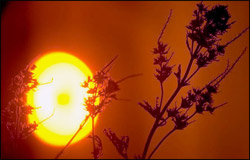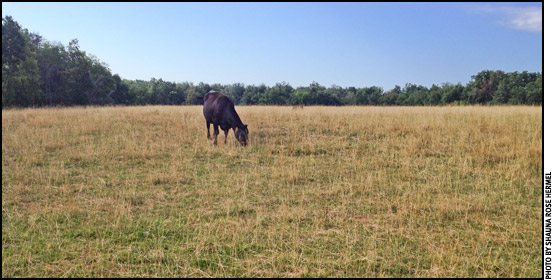Stretching Pastures During Drought
Iowa Beef Center tool offers way to find lowest-cost energy.
As the drought continues, more cattlemen are asking how to stretch their pastures. There are two major techniques that may be pursued: One is to reduce the grazing pressure from the animal side, and the other is to supplement the amount of feed available.
Animal grazing pressure can be reduced in two ways. Read more.
 Why the Scorcher?
Why the Scorcher?
It's not the heat, it's the heat dome.
Recent weeks of scorching summer heat have triggered endless talk about how hot it is. But what's causing the 100°-plus temperatures, and why are they lasting so long?
It's a massive heat dome that has grown over the central third of the nation, said Tony Lupo in early July. Lupo is chairman of the Department of Soil, Environmental and Atmospheric Science at the College of Agriculture, Food and Natural Resources, University of Missouri.
A heat dome is a kind of perfect storm of sizzling summer weather that starts with cloudless skies and the high angle of the sun in the summer, heating up the ground below, which heats the atmosphere. When a high-pressure system develops in the upper atmosphere, warmer air below it sinks. This reinforces the hot air at the surface.
Three things have made this heat dome particularly nasty, Lupo said. Read more.

Will Mayfield
Association Perspective
A commercial producer's toolbox
In my short time working for the American Angus Association, my eyes have been opened to the tools available for commercial producers. Of course, the first thing most think of is the Angus Beef Bulletin itself, as this publication is an essential part of how commercial Angus producers get news from the Association.
However, there are other tools that are quite beneficial, as well, such as recordkeeping programs; Angus Information Management Software (AIMS); and selection tools, including expected progeny differences (EPDs) and dollar values ($Values), that can be utilized to make forward progress in anyone's management system. Read more.
Managing Feedlot Heat Stress
NebGuide presents recommendations designed to help feedlots manage cattle during times of heat stress.
Cattle do not handle heat stress as well as humans. The thermocomfort zone varies greatly among beef cattle. Young animals have a narrow comfort zone between 45° F and 80°. The comfort zone of feedlot cattle and mature cows will range from 0° or below in the winter to around 75° in the summer, depending on body condition, hair coat length, coat color and plane of nutrition. This wide comfort zone allows cattle to thrive under diverse climatic conditions with little or no need for shelter or protection. However, Bos taurus cattle have difficulty coping with temperatures above 90° F when fed high-energy feedlot diets. This is particularly true with above-average humidity or below-average wind speed, when cattle have had little or no chance to adapt to excessive heat load. Read more.
Test the Forage Before You Cut
Beware of dangerous concentrate levels.
Hot, dry summer weather brings about heat and drought stress on summer annuals. Stressed plants such as the forage sorghums can occasionally accumulate dangerous concentrations of nitrates. These high-nitrate plants, either standing in the field, or fed as hay, can cause abortion in pregnant cattle, or death if consumed in great enough quantities. Nitrates do not dissipate from sun-cured hay (in contrast to prussic acid); therefore, once the hay is cut the nitrate levels remain constant.
Producers should test hay fields before they cut them for hay. Stop by any OSU County Extension office for testing details. Testing the forage before cutting gives the producer an additional option of waiting and allowing for the nitrate to lower in concentration before harvesting the hay. The major sources of nitrate toxicity in Oklahoma will be summer annual sorghum-type plants, including Sudan hybrids, sorgo-Sudans, sorghum-Sudans, millets, and Johnson grass. Read more.
What’s Inside …
In this July edition of the Angus Beef Bulletin EXTRA, you'll find valuable articles devoted to the management, marketing, and health and nutrition of your beef enterprise. Select from the tabs at the top of the page to access this month's entire offering by category. A few select features include:
- Treating Forage with Ammonia is Feed Option During Drought
- Forage Following Winter Wheat
- Ridin Herd: Interesting times in the beef industry
- Stray Mexican Cattle Captured in Texas
- University of Missouri and Industry Consortium to Announce High-Quality Cattle Strategy
- In the Cattle Markets: Corn yield slashed
- Cows Heading to Slaughter
News Briefs …
The American Angus Association and its subsidiaries generate a wealth of information to keep members and affiliates informed of what's happening within the industry as well as with the programs and services they offer. Click here for easy access to the newsrooms of the American Angus Association and Certified Angus Beef LLC and the Angus e-List archive.
A World Free of a Virulent Animal Disease?
New foot-and-mouth disease vaccine developed.
One of the most economically devastating diseases in the world for those who raise cattle, sheep, pigs, goats, deer and other cloven-hoofed animals is foot-and-mouth disease (FMD). This incredibly contagious and fast-spreading disease causes fever, blisters on the feet and mouth (hence the name), loss of appetite, drooling and lameness. Most herds affected are culled, as in the case of the 2001 outbreak in Great Britain when more than 10 million animals had to be destroyed. Read more.
Farm Safety Includes a First-aid Kit
Pack your first-aid kit for the summer.
As the pace of farm activities picks up in the summer, the likelihood of accidents also increases. That means having a first-aid kit on the farm is essential, according to J.W. Schroeder, the North Dakota State University Extension Service's dairy specialist.
"But because workplaces vary widely in their location and size, the degree of hazards that can occur, the amount of staff training and availability of professional medical services, Occupational Safety and Health Administration standards do not require farms to have specific contents in first-aid kits," he says.
He recommends starting with a basic range of first-aid items to deal with most types of injuries encountered on the farm. Read more.
[Click here to go to the top of the page.]













